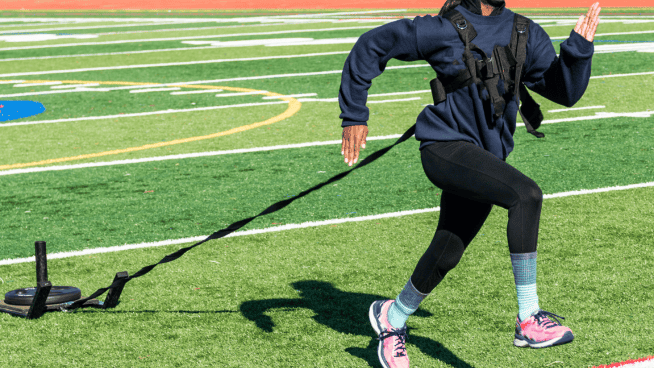How to Learn Pull-Ups (Or Anything Else for That Matter)
Marine Major Misty Posey can do 25 Pull-Ups from a dead hang. That’s more than double the required number for Navy SEALs. Before you ask—no, she’s not a gymnast, she’s not kipping and she’s certainly not a genetic freak.
She’s just short.
At 4 feet 10 inches, Posey found that she was too short for the Marine Corps Recruit Depot San Diego obstacle course. She couldn’t reach the obstacles, and even when she did, she couldn’t lift herself over them. She remembers failing one obstacle, looking at the sergeant in charge and shrugging her shoulders.
The sergeant’s response changed her life.
“He looked at me and said, ‘You need to figure it out,’” Posey said. “Then he walked away.”
After months of trial and error, she finally figured it out. Today, Posey teaches Pull-Ups to men and women who’ve never been able to do one. Most of her students complete their first Pull-Up in two days.
Posey believes her process works not just for those who want to learn Pull-Ups, but for anyone who wants to accomplish anything that seems impossible.
1. Get Your Mind Right
If you don’t believe you can do a Pull-Up, you probably won’t. Posey walked away from her initial confrontation with the Marine sergeant discouraged because she believed women were physically incapable of doing Pull-Ups. Only after she witnessed female Marines doing full Pull-Ups did she start training in earnest.
If you struggle with doubts, watch someone accomplish your goal. “Seeing is believing,” Posey says. You should also talk to your heroes if you can—you’ll find their enthusiasm to be contagious.
2. Educate Yourself
After five months of training individual Pull-Up muscles with Lat Pulldowns, Push-Ups and the Pull-Up machine, Posey was no closer to completing a Pull-Up than she was when she started. The gunnery sergeant in charge of her gym finally told her that to learn Pull-Ups, she needed to get out of the gym and onto a Pull-Up bar. She didn’t listen. He threw her out of the gym and locked the door. Five days after she started training on the Pull-Up bar, Posey completed her first Pull-Up.
Posey knows from personal experience how tricky it can be to find good information. “When it comes to Pull-Ups, there’s a lot of misinformation out there from people who mean well, but don’t know how to train,” she says. That’s why she stresses the importance of consulting many different sources and paying attention to the real-world expertise of the person giving advice.
3. Train the Right Way
When he kicked Posey out of his gym, the gunnery sergeant gave her four exercises to perform on the Pull-Up bar: Jumping Pull-Ups, Negative Pull-Ups, Partner-Assisted Pull-Ups and Half Pull-Ups. Posey saw fast results from these exercises because they all trained her neuromuscular system for the specific task she was trying to accomplish.
She’s since adopted a formula that describes this phenomenon: Specificity + Frequent Practice = Success. “If you want to get good at something, you need to do that specific thing, and you need to do it often,” she says. To give your muscles enough opportunity to learn something new, Posey recommends practicing the desired skill three to five times a week.
Do your first Pull-Up with Posey’s full workout plan.
RECOMMENDED FOR YOU
MOST POPULAR
How to Learn Pull-Ups (Or Anything Else for That Matter)
Marine Major Misty Posey can do 25 Pull-Ups from a dead hang. That’s more than double the required number for Navy SEALs. Before you ask—no, she’s not a gymnast, she’s not kipping and she’s certainly not a genetic freak.
She’s just short.
At 4 feet 10 inches, Posey found that she was too short for the Marine Corps Recruit Depot San Diego obstacle course. She couldn’t reach the obstacles, and even when she did, she couldn’t lift herself over them. She remembers failing one obstacle, looking at the sergeant in charge and shrugging her shoulders.
The sergeant’s response changed her life.
“He looked at me and said, ‘You need to figure it out,’” Posey said. “Then he walked away.”
After months of trial and error, she finally figured it out. Today, Posey teaches Pull-Ups to men and women who’ve never been able to do one. Most of her students complete their first Pull-Up in two days.
Posey believes her process works not just for those who want to learn Pull-Ups, but for anyone who wants to accomplish anything that seems impossible.
1. Get Your Mind Right
If you don’t believe you can do a Pull-Up, you probably won’t. Posey walked away from her initial confrontation with the Marine sergeant discouraged because she believed women were physically incapable of doing Pull-Ups. Only after she witnessed female Marines doing full Pull-Ups did she start training in earnest.
If you struggle with doubts, watch someone accomplish your goal. “Seeing is believing,” Posey says. You should also talk to your heroes if you can—you’ll find their enthusiasm to be contagious.
2. Educate Yourself
After five months of training individual Pull-Up muscles with Lat Pulldowns, Push-Ups and the Pull-Up machine, Posey was no closer to completing a Pull-Up than she was when she started. The gunnery sergeant in charge of her gym finally told her that to learn Pull-Ups, she needed to get out of the gym and onto a Pull-Up bar. She didn’t listen. He threw her out of the gym and locked the door. Five days after she started training on the Pull-Up bar, Posey completed her first Pull-Up.
Posey knows from personal experience how tricky it can be to find good information. “When it comes to Pull-Ups, there’s a lot of misinformation out there from people who mean well, but don’t know how to train,” she says. That’s why she stresses the importance of consulting many different sources and paying attention to the real-world expertise of the person giving advice.
3. Train the Right Way
When he kicked Posey out of his gym, the gunnery sergeant gave her four exercises to perform on the Pull-Up bar: Jumping Pull-Ups, Negative Pull-Ups, Partner-Assisted Pull-Ups and Half Pull-Ups. Posey saw fast results from these exercises because they all trained her neuromuscular system for the specific task she was trying to accomplish.
She’s since adopted a formula that describes this phenomenon: Specificity + Frequent Practice = Success. “If you want to get good at something, you need to do that specific thing, and you need to do it often,” she says. To give your muscles enough opportunity to learn something new, Posey recommends practicing the desired skill three to five times a week.
Do your first Pull-Up with Posey’s full workout plan.










